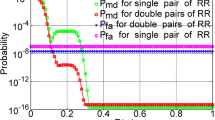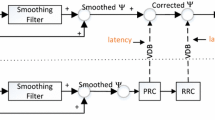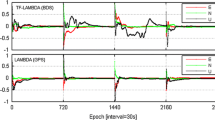Abstract
In safety-critical applications, such as the Ground-Based Augmentation System for precision approaches in civil aviation, it is important to safeguard users under the case of ephemeris failures. For CAT II/III approaches, different ephemeris monitors with approaches for ambiguity resolution are proposed with the double differenced carrier phase as the test statistics. The continuity risks introduced by the ambiguity resolution are addressed by deriving the required averaging time for new, acquired, and re-acquired satellites. Since the ephemeris fault is closely related with the baseline length between ground stations, the minimum baseline length is derived to meet the probability of missed detection region. Current methods are compared with both the averaging time and the ground baseline length. It is demonstrated that a combination of two methods is able to achieve the best performance with 94 averaging epochs and 218 m ground baseline length.




Similar content being viewed by others
Data availability
The data supporting this research is from the Hong Kong Geodetic Survey Services (SatRef) and can be obtained from https://www.geodetic.gov.hk/en/index.htm.
References
Annex-10 (2018) Volume 1, Aeronautical telecommunications - radio navigation aids (7 edn.). International Civil Aviation Organization (ICAO), Seventh Edition
Brenner M, Liu F (2010) Ranging source fault detection performance for category III GBAS. In: Proc. ION GNSS 2010, Institute of Navigation, Portland, OR, USA, September 21–24, 2618–2632
Gratton L, Pervan B, Pullen S (2004) Orbit ephemeris monitors for category I LAAS. PLANS 2004. In: Position location and navigation symposium, Monterey, CA, USA, pp 429–438
Gratton L, Pramanik R, Tang H, Pervan B (2007) Ephemeris failure rate analysis and its impact on category I LAAS integrity. In: Proc. ION GNSS 2007, institute of navigation, fort worth, TX, USA, September 25–28, 386–394
Guilbert A, Milner C, Macabiau C (2017) Characterization of tropospheric gradients for the ground-based augmentation system through the use of numerical weather models. Navigation 64(4):475–493
Jiang Y, Milner C, Macabiau C (2017) Code-carrier divergence for dual frequency GBAS. GPS Solut 21(2):769–781
Khanafseh S, Yang FC, Pervan B, Pullen S, Warburton J (2012) Carrier phase ionospheric gradient ground monitor for GBAS with experimental validation. J Navig 59(1):51–60
Khanafseh S, Patel J, Pervan B (2017) Ephemeris monitor for GBAS using multiple baseline antennas with experimental validation. In: Proc. ION GNSS + 2017, Institute of Navigation, Portland, OR, USA, September 25–28, 4197–4209
Matsumoto S, Pullen S, Rotkowitz M, Pervan B (1999) GPS ephemeris verification for local area augmentation system (LAAS) ground stations. In: Proc. ION GPS 1999, Institute of Navigation, Alexandria, VA, USA, September 14–17, 691–704
Patel J, Khanafseh S, Pervan B (2020) Detecting hazardous spatial gradients at satellite acquisition in GBAS. IEEE Trans Aerosp Electron Syst. https://doi.org/10.1109/TAES.2020.2969541
Pervan B, Chan FC (2003) Detecting global positioning satellite ephemeris errors using short-baseline carrier phase measurements. J Guid Control Dyn 26(1):122–131
Pervan B, Gratton L (2005) Orbit ephemeris monitors for local area differential GPS. IEEE Trans Aerosp Electron Syst 41(2):449–460
Pullen S, Lee J, Luo M, Pervan B, Chan F, Gratton L (2001) Ephemeris protection level equations and monitor algorithms for GBAS. In: Proc. ION GPS 2001, Institute of Navigation, Salt Lake City, UT, USA, September 11–14, 1738–1749
SARPs (2009) GBAS CAT II/III Development Baseline SARPs. ICAO NSP. http://www.icao.int/safety/airnavigation/documents/gnss_cat_ii_iii.pdf
Tang H, Pullen S, Enge P, Gratton L, Pervan B, Brenner M, Scheitlin J, Kline P (2010) Ephemeris Type A fault analysis and mitigation for LAAS. In: IEEE/ION position, location and navigation symposium, Indian Wells, CA, May 4–6, 654–666
Acknowledgement
This work is funded by the Hong Kong Polytechnic University under the scheme of the next generation GNSS integrity monitoring for civil aviation.
Author information
Authors and Affiliations
Corresponding author
Additional information
Publisher's Note
Springer Nature remains neutral with regard to jurisdictional claims in published maps and institutional affiliations.
Appendix: residual ambiguities
Appendix: residual ambiguities
For the PC_ALT method under WA,
the maximum residual Nw bounded by (9) is assumed to be 1. Similarly,
where the maximum residual N1 is also 1 assuming the correct \(N_{w}^{ij}\) input. Therefore, the residual ambiguity in the test statistics is 5N1 with the PC_ALT method,
Rights and permissions
About this article
Cite this article
Jiang, Y. Ephemeris monitor with ambiguity resolution for CAT II/III GBAS. GPS Solut 24, 116 (2020). https://doi.org/10.1007/s10291-020-01028-4
Received:
Accepted:
Published:
DOI: https://doi.org/10.1007/s10291-020-01028-4




